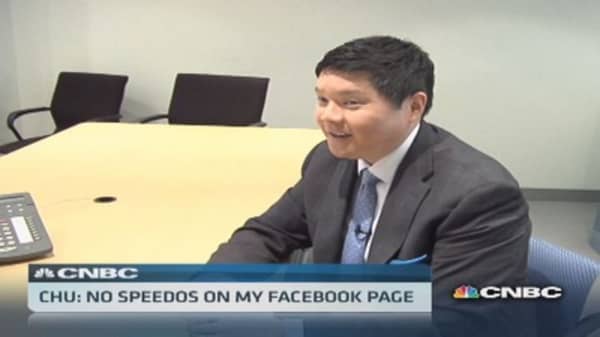It's faster, cheaper and more convenient than a face-to-face interview—no wonder companies are increasingly turning to videoconferencing to screen job candidates.
Covance, a drug development services companies based in Princeton, N.J., began experimenting with videoconferencing about two years ago as it searched for job candidates at locations in more than 60 countries.
With improvements in the job market, the "war for talent" has intensified, said Lisa Calicchio, head of recruiting at Covance.
"It used to be we could fly people in and take out time," she said. "We don't have that luxury anymore. Everyone has access to instant information, jobs are getting tweeted, and candidates are getting pinged proactively. So speed in the market really has been a driver for us."
Videoconferencing has also taken hold in companies conducting multiple rounds of interviews when filling an open post, said Robert Hosking, executive director of OfficeTeam, a global staffing company.
"If it takes more than a week to get everyone together in a room to meet a candidate, it's possible that person will be off the market before that meeting can happen," he said. "Whether it's a Skype or other video technology, there's definitely been an increase in our business."
(Read more: Adecco CEO: Temporary hiring is rising)
The practice has become commonplace within just a few years.
In a survey of more than 500 hiring managers at companies with more than 20 employees, OfficeTeam found that 63 percent said their company often uses videoconferencing for job interviews.
Beyond speed and cost considerations, using videoconferencing helps companies like Covance demonstrate effective use of technology and a nimble environment.
"I think people appreciate the flexibility," Calicchio said. "Not every candidate can hop on the plane and trudge halfway across the world and be out of pocket for three days."
But with the growth of videoconference interviewing, the technology's limitations are becoming apparent.
"It's good for a first discussion—where you get to learn some of the same things you would if you were face-to-face," said Hosking at OfficeTeam. "But you're not seeing that body language. You can't shake their hand. You can't engage ... as if you were sitting across from one another."
Such technology-driven encounters can result in more than a moment of choppy audio or awkward eye contact.
(Read more:US job openings, overall hiring reach 5-year highs)
Applicants interviewed via video are not as likely to get hired, and they think less of the hiring manager, according to a study last year by a team of Canadian researchers led by Greg Sears, a business professor at Carleton University.
In a series of mock interviews, students playing the candidates said the video sessions didn't allow them enough of a chance to make a strong impression. They also thought the people conducting the interviews were less personable, trustworthy, competent and physically attractive than those doing in-person interviews.
Meanwhile, the students playing the hiring managers were not so impressed with applicants, giving them lower scores and less often recommending them for the job.
The problem starts with the false assumption that video conversations are no different than face-to- face meetings, according to Paul Bailo, author of "The Essential Digital Interview Handbook."
"Why doesn't your joke work?" he asked. "Because of the delay in the audio response, because your eyes aren't looking at the person you're talking to, because of the distractions in the background. Any one of these things isn't a big deal. But when you put them all together, the message is garbled."
Though younger candidates may seem more comfortable with Skype, Google Hangouts or Facetime, that familiarity can work against them in a job interview, according to Hosking.
"Technology has made a lot of communication much more casual—whether we're texting or tweeting—and people may mistake an interview as being a casual discussion," he said. "But it still needs to be done in the same way you would conduct a face-to-face meeting."
According to Bailo, younger job applicants and hiring managers might not be intimidated by the technology, but they make many of the same mistakes of their older counterparts.
"They don't understand how you create digital chemistry," he said. "Most people conduct themselves as if they're talking face-to-face—not realizing they have all this technology between them getting in the way."
Too often, he said, the technology becomes a distraction.
"You're looking at the background and setup, the lighting and the shadows on their face," Bailo said. "And you're coming up with a mental score: 'Yes, I want to talk to this person' or 'No I can't wait to shut this camera off.' "
(Read more: Jobs report could show things are looking up)
Practice helps, said Bailo, who has a few tips for applicants:
—Get a good-quality camera and microphone. Set up in front of a neutral background, with good natural lighting that minimizes shadows.
—Find a quiet spot where you won't be interrupted. Nothing breaks the flow of a job interview like your dog telling you it's time for a walk.
—Get a small tripod so you can position your camera in the middle of your monitor. That way, you'll be looking straight into the camera when you're looking at the person you're speaking with.
—Dress as you would for an in-person, on-site meeting. It's a job interview.
—Make sure you cover your essential points within the allotted time (important for in-person interviews, too). Set a clock behind your monitor or keep an eye on your computer's clock.
—Do a dry run with a friend. Clean the camera lens, check the audio level, and review lighting and angles. Your comfort level with the technology will be on display, so the less troubleshooting midinterview, the better.
—By CNBC's John Schoen. Follow him on Twitter @johnwschoen or email him.





